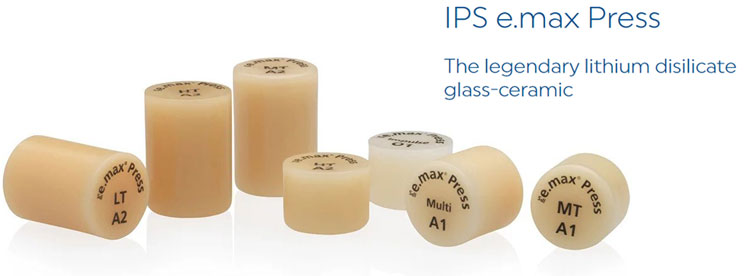IPS e.max Press is a legendary lithium disilicate glass-ceramic (LS2) for the press technique.
IPS e.max Press is a legendary lithium disilicate glass-ceramic (LS2) for the press technique. The ingots are available in five translucency levels and in an Impulse version. The polychromatic IPS e.max Press Multi ingots are particularly attractive, showing a lifelike colour transition. The ingots are selected to suit the case at hand and the preferred processing technique (staining, cut-back or layering technique). The restorations are veneered or characterized using the matching IPS e.max Ceram layering ceramic or the innovative IPS Ivocolor stains. The results look very natural, regardless of the shade of the prepared tooth.
Highlights- Exceptional esthetics - lifelike, harmonious, individual
- Efficient production - smoothly combining the pressing process with the digital printing process
- Well-thought-out assortment - a suitable ingot for virtually every dental application
- Trust builds confidence - more than 150 million restorations, a survival rate of over 96%1 and more than 15 years of experience. The IPS e.max guarantee of 10 years is as promising as the material itself.
IPS e.max Press restorations can be placed with a variety of proven luting materials, which are available for a wide spectrum of indications. Crowns and bridges made of IPS e.max Press accommodate self-adhesive and conventional luting protocols (e.g. SpeedCEM Plus). Inlays, (thin) veneers, occlusal veneers and minimally invasive 1-mm crowns are placed with the adhesive technique (e.g. using Variolink Esthetic).
IPS e.max Press MultiThe innovative Multi ingots are available in selected Bleach BL and A–D shades. The material demonstrates a natural-looking colour transition from the dentin to the incisal areas and therefore imparts monolithic restorations with a highly esthetic appearance. With these ingots, veneers and anterior, posterior and hybrid abutment crowns are fabricated quickly and efficiently. Ideally, these restorations only need to be glazed. If desired, however, they can be modified using the staining or cut-back technique.
IPS e.max Press HTHT ingots are supplied in 16 A–D and 4 Bleach BL shades. Due to their high translucency – similar to that of natural enamel – these ingots are suitable for producing small restorations (e.g. inlays). Their lifelike "chameleon effect" allows these restorations to adapt seamlessly to the natural tooth structure. The restorations are efficiently customized with the staining technique.
IPS e.max Press MTThe MT ingots are provided in the following shades: A1, A2, A3, A3.5, B1, B2, C1, C2, D2, BL2, BL3 and BL4. These medium-translucency ingots are used in cases where a brighter material than HT and a more translucent material than LT is needed. Restorations made of the MT ingots are ideal for the staining and cut-back techniques.
IPS e.max Press LTThe LT ingots are available in 16 A–D and 4 Bleach BL shades. Their low translucency – similar to that of natural dentin – renders these ingots suitable for creating large restorations (e.g. posterior crowns). The material exhibits true-to-nature brightness and chroma. The esthetic appearance of the restorations is maximized by the cut-back technique.
IPS e.max Press MOThe MO ingots are available in five group shades (MO 0, MO 1, MO 2, MO 3, MO 4). Given their opacity, these ingots are intended for the fabrication of substructures that are placed on vital or slightly discoloured prepared teeth. They form an excellent base for natural-looking restorations completed with the layering technique.
IPS e.max Press HOThe HO ingots are supplied in three group shades (HO 0, HO 1, HO 2). Due to their opacity, these ingots are used to create frameworks on severely discoloured teeth and on titanium abutments. They successfully mask dark backgrounds to achieve highly esthetic results. The anatomical shape of the restorations is customized with IPS e.max Ceram.
IPS e.max Press ImpulseThe Impulse ingots are available in two different levels of brightness (Opal 1, Opal 2). The restorations produced with these ingots have exceptionally opalescent properties. Therefore, this material is ideal for producing (thin) veneers for light teeth, which require an opalescent effect.

- Proven, high-strength material for long-lasting clinical results; flexible cementation options
- Lifelike esthetics, regardless of the shade of the prepared tooth
- Polychromatic Multi ingots for utmost efficiency
- Five levels of translucency and additional Impulse ingots for maximum flexibility
- Minimally invasive, accurately fitting restorations
- Adhesive, self-adhesive, or conventional cementation options depending on the indication
- Thin veneers (0.3 mm), veneers
- Occlusal veneers
- Inlays, onlays, partial crowns
- Minimally invasive crowns (≥ 1 mm)
- Three-unit bridges (up to the second premolar as the terminal abutment)
- Hybrid abutments and hybrid abutment crowns

The IPS e.max Press Multi ingots revolutionize the press technique. They are composed of the clinically proven lithium disilicate glass-ceramic (LS2) and show a graduated level of shade and translucency similar to that of natural teeth: The chroma and opacity of the material are higher in the cervical and dentin region, and the incisal areas are suitably translucent. Highly effective results are achieved in a single press sequence with subsequent glazing: Press in multi-colour and glaze and finish spectacularly!
With the software add-on IPS e.max Digital Press Design – Press Multi*, the sprues are automatically positioned at the virtual IPS e.max Press Multi restoration. The position of the wax pattern can be individually controlled. The milled wax objects optimized for the IPS e.max Press, e.g. ProArt CAD Wax yellow, are subsequently pressed. The IPS e.max Press Multi ingots are available in one size and in the following shades: A1, A2, A3, A3.5, B1, B2, C1, C2, D2 and BL2.

